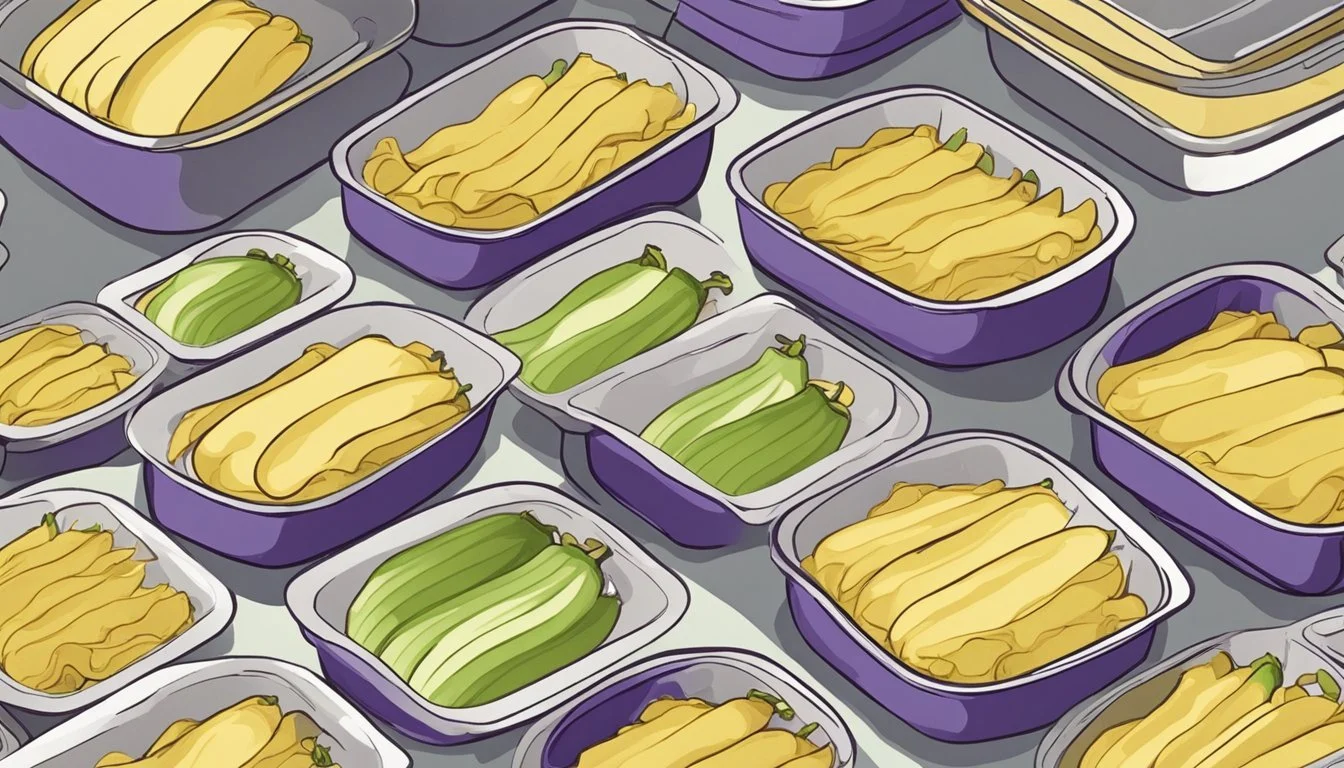How to Substitute Eggplant for Lasagna Noodles
A Guide to Low-Carb Layers
Substituting eggplant for lasagna noodles offers a nutritious twist to the classic Italian dish. Eggplant lasagna emerges as a favorable option for those seeking a gluten-free, vegetarian, and low-carb alternative that does not compromise on taste or texture. The spongy nature of eggplant makes it an ideal candidate to mimic the hearty feel of traditional pasta. By layering roasted or grilled slices of this versatile nightshade, cooks can create a satisfying meal that caters to a variety of dietary preferences while still delivering the familiar flavors and comfort of lasagna.
Crafting eggplant lasagna entails a few important steps to ensure the vegetable's natural moisture does not result in a watery dish. Sweating the eggplant by salting the slices prior to cooking is essential; it draws out excess liquid and concentrates the eggplant's flavor. Roasting the slices until they become soft and golden-brown not only develops a deeper flavor but also achieves a texture robust enough to stand up to the rich layers of cheese and sauce. This preparation method positions eggplant as a healthful and palatable alternative to noodles, aligning well with the growing interest in vegetable-centric cuisine.
As more individuals pivot towards healthier eating habits, eggplant lasagna stands out as a resourceful and delectable option. The inclusion of this fiber-rich ingredient contributes to a lighter version of the dish without overlooking the comfort provided by the classic. Whether served for a family dinner or as part of a special occasion menu, this adaptation of lasagna is bound to satisfy both the health-conscious and those simply looking for a tantalizing new take on an old favorite.
Understanding Eggplants
When substituting eggplant for noodles in lasagna, selecting quality eggplants and preparing them properly is essential to ensure a delicious outcome.
Choosing the Right Eggplants
One should look for eggplants that have smooth, shiny skin and are heavy for their size. These attributes are indicative of freshness and good texture. The color should be a deep purple, and the eggplant should be firm yet give a slight pressure. Smaller to medium-sized eggplants tend to have fewer seeds and are less bitter, making them ideal for lasagna layers.
Prepping Eggplants for Lasagna
Proper preparation of eggplants is crucial for lasagna. The process begins with preheating the oven—setting it between 350-400 degrees Fahrenheit (177-204 degrees Celsius) depending on the recipe specifics.
Roasting Instructions:
Wash the eggplants and trim off any excess stem.
Cut the eggplants lengthwise into slices about 1/4-inch thick for optimal texture.
Arrange the slices on a baking sheet, preferably lined with parchment paper for easy removal.
Lightly brush each slice with olive oil. This helps in the roasting process, contributing to a golden color and tender texture.
Season the eggplant slices with kosher salt and freshly ground pepper to enhance flavor.
Place the eggplant in the preheated oven and roast until the slices are soft and pliable, which typically takes 20-25 minutes. Flipping is recommended halfway through for even cooking.
After roasting, the eggplant slices are ready for layering in the lasagna, replacing traditional noodles with a nutritious, low-carb alternative.
Layering the Lasagna
When substituting eggplant for lasagna noodles, it's essential to layer the ingredients effectively to maintain the structure and flavor depth of the dish. The eggplant slices assume the place of noodles, serving as the dividing layers between the cheese and sauce.
First Layers
The construction of lasagna begins by laying the foundation in the baking dish. One should start with:
A thin layer of marinara sauce on the bottom to prevent sticking.
A layer of roasted eggplant slices over the sauce, ensuring they overlap slightly.
Spread a layer of ricotta cheese on top of the eggplant.
Optional: Sprinkle fresh basil leaves over the ricotta for additional flavor.
Mid Layers
The middle layers continue to build complexity and taste:
Another layer of marinara sauce over the ricotta.
Mozzarella cheese should be evenly spaced over the sauce.
Parmesan cheese can be lightly dusted for an added savory note.
Repeat these steps, maintaining the order of eggplant, ricotta, marinara sauce, mozzarella, and Parmesan until the baking dish is nearly full, usually two or three times.
Top Layers
The final layers will form the surface of the lasagna that achieves a golden brown appearance once baked:
End with a layer of eggplant slices.
Cover generously with marinara sauce to keep the top moist.
Finish with a final layer of mozzarella and Parmesan cheese.
The top should be covered enough with cheese to create a bubbling, golden brown crust once baked.
Crafting Cheesy Fillings
Creating the perfect cheese filling for an eggplant lasagna involves paying close attention to the blend and seasoning of the cheeses. A well-balanced cheese filling contributes to the overall richness and flavor of the dish.
Ricotta Mixture
The ricotta mixture is foundational for the cheese filling. It typically consists of:
Ricotta cheese: Serves as the creamy base.
Egg: Usually one egg is enough, acting as a binder.
Garlic: Finely minced for a subtle hint of flavor.
Italian seasoning: Adds the traditional herby taste.
Black pepper: Freshly ground to preference.
Here is a basic guideline a cook might follow for crafting the ricotta mixture:
Combine 15 ounces of ricotta cheese with 1 beaten egg for consistency.
Mix in 1-2 minced garlic cloves and a teaspoon of Italian seasoning.
Season with black pepper to taste.
Mozzarella and Parmesan Layers
These cheeses provide the melty texture and salty, sharp taste that complements the other layers.
Mozzarella: Provides gooeyness and melts well.
Parmesan: Offers a nutty bite, enhancing the lasagna’s flavor profile.
The process involves:
Shredding 8 ounces of mozzarella and setting it aside.
Grating approximately a half cup of Parmesan.
A cook might layer these cheeses between sections of eggplant and ricotta mixture, finishing with a generous topping of both mozzarella and Parmesan on the uppermost layer.
Baking and Presentation
To ensure a delicious eggplant lasagna, proper preparation of the baking dish, precise oven baking, and attractive serving suggestions are key.
Preparing the Baking Dish
Before one begins layering their eggplant lasagna, it's essential to prepare the baking dish correctly. It should be lightly coated with oil to prevent sticking. Using a brush or paper towel, one can spread a thin layer of olive oil across the bottom and sides of the dish.
Oven Baking
Preheat the oven to a temperature of 350 degrees Fahrenheit (175 degrees Celsius). Assemble the lasagna by creating layers of roasted eggplant, sauce, and cheese. Once assembled, cover the dish with aluminum foil and place it in the center rack of the oven. Bake until the cheese is bubbly and the flavors meld together, which typically takes about 25 to 30 minutes. To achieve a golden-brown topping, remove the foil and bake for an additional 10 minutes.
Tip: To check for doneness, insert a toothpick into the center; it should go through layers easily.
Serving Suggestions
When serving baked eggplant lasagna, accompanying it with a side can enhance the meal experience. Options like garlic bread offer a crunchy texture that contrasts the softness of the lasagna, while a fresh salad adds a vibrant, crunchy, and acidic component to balance the richness of the cheese and eggplant. Cut the lasagna into squares and serve hot for the best texture and flavor.
Alternative Dietary Considerations
Substituting eggplant for lasagna noodles caters to various dietary requirements, offering a gluten-free, low-carb, and potentially vegan dish. These adjustments ensure that individuals with specific dietary preferences or restrictions can still enjoy the rich flavors of lasagna.
Making Vegan Eggplant Lasagna
To craft a vegan eggplant lasagna, one must replace traditional cheese with plant-based alternatives. Tofu ricotta is a popular choice, typically made by blending firm tofu with lemon juice, nutritional yeast, garlic, and basil to create a mixture with a texture similar to ricotta cheese.
Vegan Cheese: Opt for commercially available vegan cheese or make a homemade version using soaked cashews, nutritional yeast, garlic powder, and lemon juice blended until smooth.
Non-dairy milk: Use almond milk or any plant-based milk to add creaminess if needed.
Gluten-Free and Low-Carb Options
Individuals following a gluten-free or low-carb diet will find eggplant an ideal substitute for traditional noodles in lasagna. Eggplant's meaty texture makes it suitable for layering and it absorbs flavors well during baking.
Zucchini: Thinly sliced zucchini can also replace noodles, adding a fresh, light layer to the lasagna without the gluten or heavy carbs.
Butternut Squash: For a slightly sweet variant, butternut squash slices are an excellent gluten-free option that complements the savory components of lasagna.
By incorporating these alternatives, eggplant lasagna becomes accessible to those following vegan, vegetarian, gluten-free, or low-carb lifestyles, ensuring no compromise on taste or texture.
Properly Storing Lasagna
Correct storage of lasagna not only ensures safety but also maintains the dish's flavor and texture. Whether refrigerating leftovers for a short-term fix or freezing for future meals, proper technique is key.
Refrigerating Leftovers
To refrigerate leftover lasagna, one should let it cool to room temperature first, which typically takes about 30 minutes. Avoid leaving lasagna out for longer than 2 hours to prevent bacterial growth. Once cooled, individual portions or the entire lasagna can be transferred to an airtight container or wrapped tightly with aluminum foil or plastic wrap. This keeps out air and moisture, preserving the lasagna's quality. Leftovers should be consumed within 3-5 days, and when reheating, ensure it reaches an internal temperature of 165 degrees Fahrenheit.
Freezing for Long-Term Storage
Lasagna is an ideal candidate for freezing, making it a convenient option for meal prep. To freeze, either:
Wrap the whole baked lasagna (cooled to room temperature) in layers of plastic wrap, followed by aluminum foil.
Divide into portions and store in separate freezer-safe containers or bags.
When sealing, one must eliminate as much air as possible to prevent freezer burn, which affects taste and texture. Properly stored, frozen lasagna can last for up to 3 months. To reheat, one can choose to thaw it overnight in the refrigerator or cook it from frozen, adding additional cooking time. Always cover with foil when reheating in the oven to avoid drying out.
Nutritional Information
When substituting eggplant for noodles in lasagna, one is opting for a meal that is not only comforting but also aligns with a healthy vegetarian dinner. The nutritional content of eggplant is a key factor in making lasagna a more nutritious option, particularly in terms of caloric content and protein and fiber counts.
Caloric Content
Eggplant is notably low in calories, making it an excellent choice for those seeking to reduce their calorie intake without sacrificing portion sizes. On average, one cup of raw eggplant contains approximately 20 calories, compared to traditional lasagna noodles which contain about 200 calories per cup. By replacing noodles with eggplant, the overall calorie count of the dish significantly decreases.
Protein and Fiber Counts
Replacing noodles with eggplant does alter the protein and fiber composition of the dish. Eggplants naturally provide a modest amount of protein and are a good source of dietary fiber. Here's a brief overview:
Protein: A cup of eggplant offers around 1 gram of protein, which is less than that of lasagna noodles. However, the protein can be supplemented by incorporating cheese or meat in the lasagna layers.
Fiber: Eggplant shines in its fiber content, with approximately 3 grams per cup. Fiber is essential for digestive health and can make the meal more satiating.
Utilizing eggplant in lasagna contributes to a fiber-rich, lower-calorie version of this classic comfort food, maintaining its satisfying quality while enhancing its nutritional profile.
Exploring Variations
When substituting eggplant for lasagna noodles, one has endless possibilities to tailor the dish to their preference, whether they seek a meat-inclusive version with different types of ground meats or opt for a completely vegetarian experience with a variety of other vegetable substitutes.
Meat-Inclusive Versions
In meat-inclusive variations of eggplant lasagna, chefs can opt for ground beef or Italian sausage to create a rich and flavorful meat sauce. Ground turkey is an excellent alternative for those looking for a lighter option but still desire the hearty texture and taste that meat provides.
Beef: Use lean ground beef to achieve a classic lasagna taste.
Italian Sausage: For a spicier kick, Italian sausage, either mixed with beef or on its own, adds depth.
Turkey: Ground turkey serves as a healthier substitute with a lighter flavor and less fat.
A layering of sautéed mushrooms or spinach can be included to complement the meats and add nutritional value.
Vegetable Substitutes
Aside from eggplant, other vegetables can star in lasagna, either alongside the eggplant or as an additional substitute. They can form layers or be incorporated into a meatless sauce.
Mushrooms: These can offer a meaty texture and rich flavor, especially when sautéed and layered in.
Spinach: It's common to mix spinach with ricotta for a creamy, nutritious layer.
Zucchini Lasagna: Using zucchini in place of or alongside eggplant adds a different texture and taste profile.
For a completely meatless version, one can layer various vegetables, such as zucchini or mushrooms, with a robust tomato sauce to ensure the lasagna is moist and flavorful.







